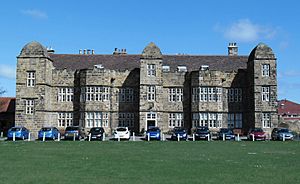Sir William Pennyman, 1st Baronet facts for kids
Sir William Pennyman (born 1607 – died 1643) was an important English landowner, soldier, and politician. He lived during a time of big changes in England, including the English Civil War.
Contents
Early Life and Family
William Pennyman was born in 1607. He was the son of William Pennyman, who worked as a Clerk in Chancery. This was a job in the legal system. William Pennyman went to two famous places for his education: Christ Church, Oxford and Inner Temple.
Family Connections
His father bought part of the Marske estate in Yorkshire in 1616. This area is now called Redcar and Cleveland. William Pennyman later married Ann Atherton. She was the granddaughter of John Atherton and also Sir John Byron. Ann brought the rest of the Marske estate into the family.
Marske Hall and Wealth
In 1625, Sir William Pennyman built a grand house called Marske Hall. This house is still standing today. He became very wealthy from mining a mineral called alum on his Marske estate. Alum was used for many things, like making dyes stick to fabric.
Supporting the King
Sir William Pennyman was a strong supporter of King Charles I. He held several important jobs for the King.
Important Roles
- He was a member of the Council of the North. This group helped the King govern the northern parts of England.
- He also worked as an officer of the Star Chamber. This was a special court that dealt with serious crimes against the King.
- King Charles I made him a Baronet on May 6, 1628. A Baronet is a special title of honor, like a knight but passed down through the family.
Public Service
- From 1635 to 1636, he was the High Sheriff of Yorkshire. This was a very important local official role.
- Later, he became a Deputy Lieutenant for Yorkshire. This meant he helped organize the local military forces.
Soldier and Politician
Sir William Pennyman was also involved in politics and military matters.
Military Service
- In 1638, he put together a group of soldiers called a Regiment of Foot. These soldiers were part of the Yorkshire Trained Bands. They helped in a war against the Scots.
- When the English Civil War started, he and his half-brother James raised another regiment. Sir William led these soldiers for the King.
- He fought in important battles like the Battle of Nottingham and the Battle of Edgehill in 1642.
Member of Parliament
- He was chosen to be a Member of Parliament for Richmond. He served in both the Short Parliament and the Long Parliament from 1640 to 1642.
- However, he was stopped from being a Member of Parliament in 1642.
Later Life and Death
King Charles I appointed Sir William Pennyman as the Governor of Oxford. This was a very important job, especially during the Civil War. Sir William Pennyman sadly died in Oxford in 1643. He passed away from the plague, a serious disease at the time. After his death, the Marske estate went to his half-brother, James. James later became the first Baronet Pennyman of Ormesby in 1664.


